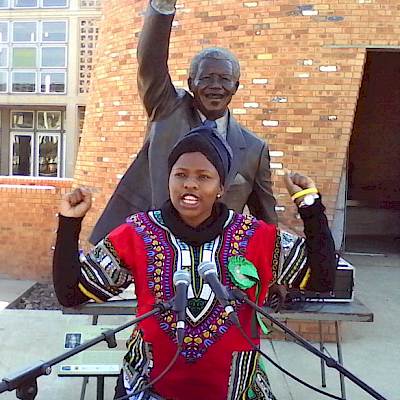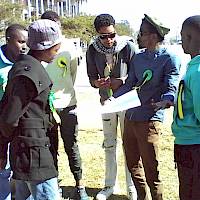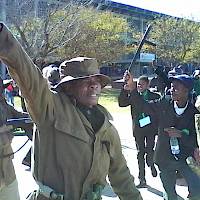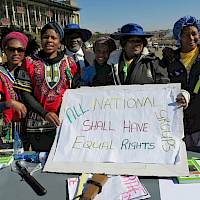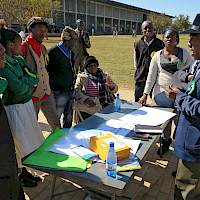Public Time Travel at Walter Sisulu Square/Freedom Square, Kliptown
Freedom Charter 1955/2015, 25 June 2015
Goal
To make South African citizens of all races to reflect on the importance and meaning of the Freedom Charter document, then and now.
To express the Freedom Charter today, how do we make South Africa an inclusive country for everybody?
The first part is a historical event, giving the atmosphere of the Congress of the People in 1955. The second part is the interpretation of the Freedom Charter 2015. What do the ten clauses mean in today’s South Africa?
Historical facts
The idea of the Freedom Charter was first proposed by Prof. Z.K. Matthews at the Cape annual conference of the African National Congress (ANC) in Cradock in August, 1953.As the President of the ANC in the Cape, Matthews in his presidential address proposed convening a Congress of the People to draw up a Freedom Charter. At the meeting of the National Executive of the ANC held in Natal in March 1954, which Matthews was part of, it was resolved that action should be taken to introduce the concept of the Congress of the People to the National Executives of the South African Indian Congress (SAIC), South African Coloured’s People’s Organization (SACPO), and the South African Congress of Democrats (COD). Later in the same month, a joint meeting of the national executives of the above-mentioned organization was held in Natal. This non-racial united front was known as the Congress Alliance, and in this forum it was decided that a National Action Council should be established, and its responsibility was to ensure the implementation of the idea of the Congress of the People. The newly established National Action Council comprised of Chief Albert Luthuli (chairman), and the secretariat consisted of Stanley Lollan (SACPO), Lionel Bernstein (COD), Yusuf Cachalia (SAIC) and Walter Sisulu (ANC), however Sisulu was later replaced by Oliver Tambo due to banning orders which forced him to resign.
A series of rallies and campaigns, big, small and secret meetings were held in houses, flats, factories, kraals, on farms and outdoors in many parts of the country. In 1955 the ANC sent fifty thousand volunteers countrywide to collect freedom demands from the masses of South Africa. These demands were written on all sorts of things that people could write on including, discarded pieces of corrugated cardboards.
Delegates for the Congress of the People were elected at public meetings; slogan: “delegates from every town, every suburb and every village”
In April and May 1955 the documents arrived in Kliptown. A committee of the National Action Council sorted the demands and suggestions into various categories. The practical preparations for receiving all the people in Kliptown were made by many, many foot soldiers in the volunteer corps.
25-26 June the Freedom Charter was read and adopted by three thousand people at an open field in Kliptown, probably the most representative gathering in the history of South Africa. The police stopped thousands of people to arrive at the meeting and finally dispersed the crowd on the second day.
The Freedom Charter is one of the most important documents demonstrating an equal and democratic society. It is the basis for the constitution of South Africa today.
Historical event, Kliptown 1955
Scenario, The Congress of the People, 25-26th June 1955
Thousands of people have arrived at the dusty sports field in Kliptown. There are people of all races, social background, ages, men and women, from all over the country. They have been elected as representatives to go to this meeting in Kliptown. They are well prepared what to say and anybody can motivate and present their demands of a new South Africa, an inclusive country for all.
Many “Freedom volunteers” have worked hard to collect all the requests and desires from suburbs, work places and villages. They have given an oath to show their commitment. But the work is still not over. The volunteers now give all the practical support that is needed to organize this big meeting.
The visitors from all over the country, and from Kliptown, have received their rosettes. Some of them sit down on the stones. Everybody is waiting for the Congress of the People to start. It is an excited atmosphere with a lot of expectations.
Today the Freedom Charter will be finalized, the dreams for a new South Africa will be discussed and expressed in words, illustrations, slogans, poems and songs and finally adopted by the crowd. This is the country we want to live in!
Roles
The participants are the people who have arrived in Kliptown for the Congress of the People, in 1955, from all over the country and from the neighbourhood
Local people who help and serve, “Freedom Volunteers”
Leaders of the time
1950s clothing if possible
Schedule (09.00-11.00)
Registration, Rosettes are handed out
Welcome, National anthem, Presentation of the event,
Short speech by Swedish Ambassador Anders Hagelberg
Key note address by Deputy Minister of Arts and Culture Rejoice Mabudafhasi
Program of the day
Initiation
Nkosi Sikelel’
Leaders of 1955 address
Songs, music and slogans from 1950s
Reading the clauses/inputs/adopt the clauses
Interruption by the police
The crowd comes together again singing and dancing
Ending of the historical event
Instruction for Freedom Charter 2015
The Freedom Charter 2015
The aim is to interpret the Freedom Charter 2015. What does each of the ten clauses mean in today’s South Africa?
Key Questions
- “How do we make South Africa a happy place for all?” An inclusive country for everybody, regardless the colour of skin, income, social position or country of origin? How do we reach social cohesion? Is it possible?
- What does Freedom mean? What is the kind of country we want to live in? What are our dreams of today? How do we express it within the ten clauses of the Freedom Charter?
Activities (11.00-12.40)
There are ten groups, one for each clause. In each group the purpose is to express the clause and how it contributes to social cohesion, a country for all, dreams of today. This is the country we want to live in! Express in words, posters, placards, slogans, songs, plays, poems…
The visitors from the provinces bring what they have prepared, finalize it and get ready for the presentations.
The ten groups: The people shall govern/democracy; Equal Rights for All; Share the Wealth; Share the Land; Equal before the Law; Human Rights; Work and Security; Learning and Culture: Houses, Security and Comfort; Peace and Friendship
Soup (with or without meat) is served during activities
Presentations/Performances (12.40-13.40)
Each of the clauses will be read and then interpreted in a poem, short speech, illustration, play, song, poem… (5 minutes for each clause)
Ending ceremony (13.40-14.00)
Ending ceremony, candles, words of wisdom
Lunch
Time Plan
07.00 Prepare the site
09.00 Registration, rosettes are handed out
10.00 Welcome address by Khwezi Gule, Director of Hector Pieterson/Kliptown Museum and Louise Graham, Chief Director, Departments of Arts and Culture
Short speech by Swedish Ambassador Anders Hagelberg
Key note address by the Deputy Minister of Arts and Culture, Rejoice Mabudafhasi
Program of the day, Annina Ylikoski, Bridging Ages/Regional Council Ostrobotnia, Finland
10.30 Kliptown 1955
Initiation, Ebbe Westergren, Bridging Ages/Kalmar läns museum, Sweden
Nkosi Sikelel’
Welcome address to the delegates, Radikobo Ntsimane, KZN Museum Services
Reading of the ten clauses, Inputs from the audience
Songs and slogans from 1950s
Adopting of the ten clauses
11.00 Disturbance by police, The crowd comes together singing
11.00 Ending of the historical event
Soup during activities
11.15 Freedom Charter 2015
Instructions of the activities, Jabulani Phelago, Bridging Ages South Africa/Freedom Park
11.20 Activities in ten groups, Freedom Charter today, “An inclusive country for all”
12.40 Common gathering. Presentations and Performances from each of the ten clauses
13.40 Ending ceremony, words of wisdom, Ebbe Westergren
14.00 End
Lunch
6th May/28th May 2015
Bridging Ages South Africa
Bridging Ages International
Image gallery:
- Time Travel at Korsholm’s castle 1395
- Time Travel La Dahlia 1980
- Time Travel, Belgrade Fortress 1460
- Freedom park Time Travel
- Time Travel at the Palatine 404 AD
- Time Travel at Villa dei Quintilii 180 AD
- Time Travel event, Uhuru Gardens 11th December 1963
- Time Travel event at the Dominican Priory in Reval in 1483
- Time Travel, the Freedom Charter in Kliptown 1955
- Time Travel, Gathering at Elands river 4000 years ago
- Time Travel, Kisumu railway station
- Time Travel at Tallinn School No 8, Estonian SSR in 1986
- Time Travel, Roodewal farm 1913
- Time Travel at The Old Fort Johannesburg Prison (Constitution Hill) Student uprise 16th June, 1976
- Time Travel, Kläckeberga Manor 1903
- Public Time Travel at Walter Sisulu Square/Freedom Square, Kliptown
- Time Travel, Kenyatta University Primary School 1970
- Time Travel, Råby Dairy 1900
- Time Travel, Wolvekloof 1773
- Time Travel, Södra Bruket 1900
- Time Travel event, Maseno school 1928
- Time Travel, Västraby Stone Age settlement 5000 years ago
- Time Travel, Fredriksberg Manor 1887
- Time Travel, Bain's Kloof Pass 1853
- Time Travel Mamre. Groene Kloof March 1808
- Time Travel, Eketorp fort 1170
- Time Travel, Torslunda 1741
- Time Travel, Rudd House, Kimberley 1907
- Time Travel, Mayibuye uprising, Galeshewe 1952
- Time Travel event on curriculum transformation, focused on History, 1995
- Time Travel Wildebeest Kuil 1856
- Time Travel Freedom Tree, Entebbe 1954
- Time Travel event, Manyatta in Ngurunit
- Time Travel, Smyrna Athena Temple 590 B.C.
- Time Travel, Ikageng, Potchefstroom 1986
- Time Travel, Yesilova 6000 B.C.
- Time Travel event at Shaurimoyo Primary School 1972
- Time Travel event at Freedom Park on transformation of the Curriculum, focused on History, 1995
- Time Travel, Manisa 1955 - The Green City?
- Time Travel event at the Magistrate’s Court in Krugersdorp 1919
- Time Travel, Wedding in Smyrna 590 B.C.
- Time Travel event, Castle of Good Hope, Cape Town 1668
- Smyrna 590 B.C. Time Travel Photos
- Mathematics in the Historic Environment, Time Travel, Kenyatta University Primary School February 2015
- Time Travel event at the District Commissioner’s Office in Meru in 1964
- Time Travel event on the post-election violence 2007/ 2008
- Time Travel, Tin Town, Gamalakhe, October 1968
- Time Travel event at Abrams Road, Promosa 1971
- Time Travel, Preparing for the welcoming of Karen and Bror Blixen in their new house in 1917
- Time Travel event on the Court Martial, March 1906 in Mthwalume
- Time Travel event at Vezaiciai Manor 1888
- Fort Nongqayi, Time Travel 1906
- Time Travel event at Rabai 1848
- Time Travel at Timacum Minus Roman fort 370 AD
- Time Travel event Entebbe Za Mugula 1860
- Time Travel, the Darüssifa in Manisa 1533
- Time Travel on Giresun Island 800 B.C.
- Public Time Travel at Freedom Square, Kliptown, Freedom Charter 1955/ 2015
- Time Travel on the Freedom Charter 1955, W.W. Brown Baptist Church, Kliptown
- Time Travel, Port Shepstone Railway Station 1973
- Time Travel at the Port Shepstone Harbour 1905
- Time Travel at the Old Prison in Pietermaritzburg 1910
- Time Travel, Isivivane uShaka, Mthwalume, Umzumbe 1828
- Late Iron Age in Grelsby 895 AD
- Time Travel, Emaus Mission Station 1904
- Time Travel, Betania Mission, Nyandezulu 1912
- Time Travel, Pilgrim’s Rest 1922
- Time Travel, Bain’s Kloof pass 1853
- Time Travel event the Old Fort Johannesburg Prison (Constitution Hill) 1976
- Time Travel, Pniel mission station 1849
- Time Travel, Lwandle 1986
- Time Travel, Clanwilliam (Kweekkraal, Elizabethfontein, Algeria) on relations between hunter-gatherers and pastoralists
- Time Travel at Gustaf Eriksson’s aunt, Södra Gatan 8, Mariehamn, 1905
- Pellas skeppargård (Shipowner’s homestead) in 1884
- Time Travel in the park by the bathhouses (Badhusparken) 1900
- Time Travel event, The troubles coming to our village in 1971
- Time Travel, Assegaaibosch Manor House, Jonkershoek
- Time Travel, Klipgat Cave, Walkers Bay, Gaansbaai, 1800 years ago
- Time Travel, Nduli, Ceres 1962
- Time Travel at the Dutch Reformed Mission Church in Montagu 1968
- Farfa Abbey 775 AD
- At the log-cabin of the Edblad family in 1872
- Time Travel, Kapenguria Museum
- Time Travel, Tukums regions Song Festival 1928
- Time Travel, Coming of the missionaries, Kiwafu village 1879
- Justice and leadership in Kigungu village 1860.
- Time travel Kraaipan in the start of the South African war, October 1899
- Time Travel Bloemfontein 1912
- Time Travel at Mqhekezweni Great Place. Grooming of a leader (Mandela) 1934
- Time Travel and Therapy. St. Martin's Children home 1999
- Time Travel, Mthwalume Mission 1859
- Time Travel on the Samora Machel plane crash, Inaugeration of the monument 1999

